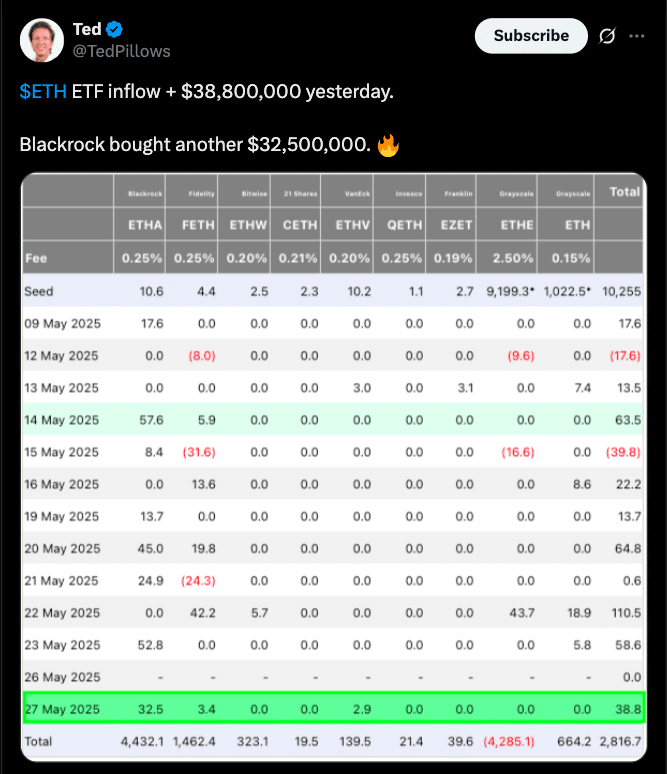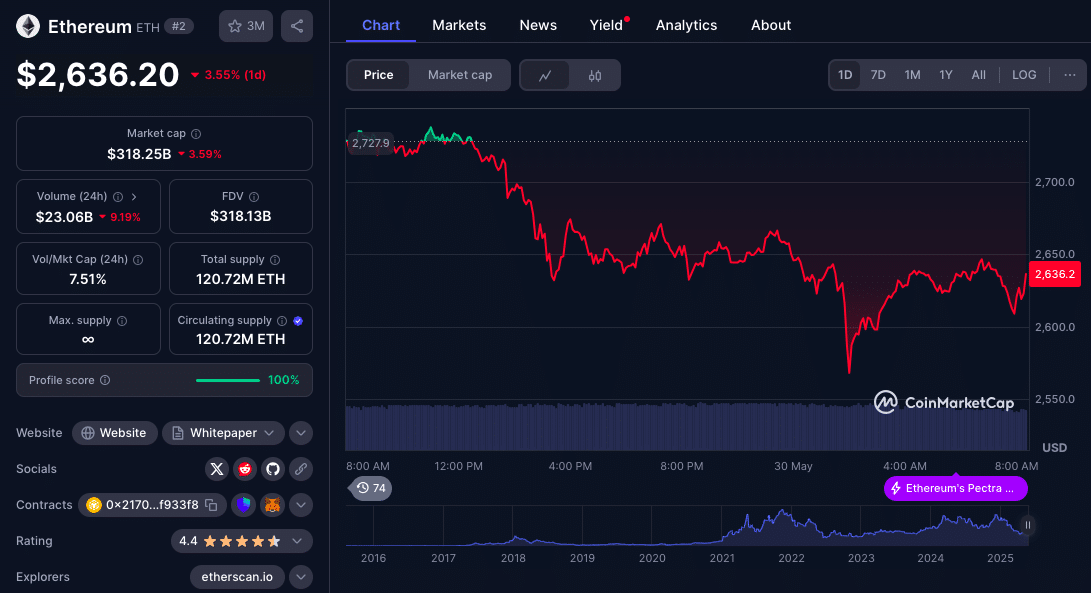After a quiet period of price action and lack of narratives, Ethereum has popped back up. Analysts believe the $71 million Ethereum ETF inflows from financial giants like BlackRock is one of the contributing catalysts to its upward move. Institutional confidence, plus Ethereum’s on-chain dominance in bridged flows and stablecoin growth has bulls asking: is $2,900 ETH next?
- Institutional Confidence Returns: $71 Million in ETF Inflows
- On-Chain Data Confirms the Shift
- Is $2,900 the Price Next for ETH?
- Institutional Backing and Stablecoin Strength
- Conclusion
- FAQs
- Why did Ethereum ETF inflows hit $71 million?
- What does the RSI mean for Ethereum’s price?
- How do stablecoin flows impact Ethereum?
- Is $2,900 realistic for Ethereum?
- How is Ethereum benefiting from institutional support?
- Glossary of Key Terms
Institutional Confidence Returns: $71 Million in ETF Inflows
Based on available data, May 27 saw $38.8 million in net inflows into Ethereum ETFs, one of the highest single-day totals since their inception. BlackRock contributed $32.5 million of that total, one of the biggest players in Ethereum’s institutional space. Other funds like ETHA and FETH revealed more confidence in Ethereum’s long-term prospects, especially after outflows from firms like Fidelity and Franklin.
Experts are saying this is proof institutions aren’t just dipping their toes in crypto but they’re planting their flags. BlackRock’s big push tells the market Ethereum’s fundamentals might actually be too good to ignore.

These flows are really enhancing Ethereum market rebound. After several months of outflows from crypto funds, the Ethereum ETF inflows indicate a new investor behavior with capital rotating back into high-liquidity digital assets.
On-Chain Data Confirms the Shift
While ETF inflows are a big narrative, Ethereum’s on-chain data backs it up. Recent data from Artemis shows Ethereum leading in multiple areas: bridged net flows and stablecoin supply growth.
Market sources report that Ethereum had the largest net inflow of assets across bridges, meaning capital is flowing into Ethereum’s ecosystem faster than other networks. Stablecoin issuance on Ethereum has also surged, meaning liquidity is not only coming back but growing.
This combination of increased capital inflows and more liquidity means institutional players are sitting for long-term exposure to Ethereum-based DeFi. Bridged flows and stablecoin growth mean Ethereum isn’t just getting speculative capital; it’s getting builders, protocols, and real liquidity. This is a sign of a maturing ecosystem, not just a market pump.
Is $2,900 the Price Next for ETH?
At the time of this publication, ETH was at $2,636, local resistance is at $2700, with a clear bullish bias. RSI is at 70.47, which is overbought and CMF was 0.15, which is positive.

If Ethereum can close above $2,720 with strong volume, analysts say a move to the $2,900 level becomes possible. This is a big psychological level and a clear target. But the RSI is getting overbought so there might be a short term pullback or consolidation before the next leg up.
The $2,900 target isn’t just technical, it’s psychological. Breaking past that level could spark FOMO buying from retail and institutional investors alike. But if momentum falters, the market might see ETH range trading before the next push.
Institutional Backing and Stablecoin Strength
The focus on Ethereum’s ETFs and on-chain strength is particularly interesting with the growing stablecoin usage. Ethereum is still the backbone for major stablecoins like USDT, USDC and DAI, with increasing issuance showing more confidence in its Layer 1 scalability and security.
Notably, the bridged flows are back and capital is flowing from other ecosystems (Solana, Avalanche, Arbitrum) back into Ethereum. This is a “flight to safety” as Ethereum is perceived as more resilient in the current market volatility and regulatory uncertainty.
While the signs are good, there are risks. The fast inflows and price momentum can lead to over extension. If macro headwinds (rate hikes or regulatory crackdowns) happen, Ethereum’s momentum might stall. Additionally, the RSI is high so there might be some profit taking in the short term.
However, the combination of institutional capital, on-chain activity and liquidity is looking good. Ethereum is set to rally provided it can clear the resistance with good volume.
Conclusion
Ethereum’s latest move with $71 million in ETF inflows and backed by leading on-chain metrics reveals that the market is waking up to the protocol’s value. BlackRock’s big investment shows the depth of institutional confidence just as stablecoin growth and bridged flows shows the strength of the ecosystem.
If Ethereum can hold and break $2,720, the $2,900 level is possible. But signs of exhaustion must be watched as the move matures.
FAQs
Why did Ethereum ETF inflows hit $71 million?
Institutional interest is back, with BlackRock adding $32.5 million. This is a sign of confidence in Ethereum’s fundamentals and ecosystem.
What does the RSI mean for Ethereum’s price?
RSI 70.47 is a strong buy but also overbought, traders are to be prepared for a short-term pullback.
How do stablecoin flows impact Ethereum?
More stablecoin issuance on Ethereum means more liquidity,and it’s the leading Layer 1 platform, attracting capital and DeFi activity.
Is $2,900 realistic for Ethereum?
If ETH closes above $2,720 with volume, a move to $2,900 is possible. But watch for consolidation if momentum slows.
How is Ethereum benefiting from institutional support?
With BlackRock leading the ETF inflows, Ethereum is becoming a long-term digital asset investment and driving liquidity and adoption.
Glossary of Key Terms
ETF (Exchange-Traded Fund): a fund traded on stock exchanges that tracks the performance of an underlying asset, in this case, Ethereum.
Bridged Net Flows: transfer of assets from one blockchain to another, meaning cross-chain liquidity movements.
Stablecoin: cryptocurrency pegged to a stable asset like the US dollar, used to reduce volatility and provide liquidity.
RSI (Relative Strength Index): a momentum indicator used in technical analysis to measure the speed and change of price movements.
CMF (Chaikin Money Flow): indicator that measures buying and selling pressure based on volume and price movements.



















































































































